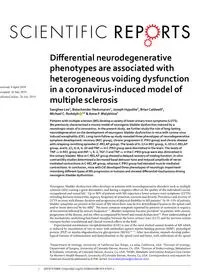
2019 Differential neurodegenerative phenotypes are associated with heterogeneous voiding dysfunction in a coronavirus-in PDF
Preview 2019 Differential neurodegenerative phenotypes are associated with heterogeneous voiding dysfunction in a coronavirus-in
1 Scientific RepoRts | (2019) 9:10869 | https://doi.org/10.1038/s41598-019-47407-x www.nature.com/scientificreports Differential neurodegenerative phenotypes are associated with heterogeneous voiding dysfunction in a coronavirus-induced model of multiple sclerosis Sanghee Lee1, Balachandar Nedumaran2, Joseph Hypolite2, Brian Caldwell2, Michael C. Rudolph 3,4 & Anna P. Malykhina2 Patients with multiple sclerosis (MS) develop a variety of lower urinary tract symptoms (LUTS). We previously characterized a murine model of neurogenic bladder dysfunction induced by a neurotropic strain of a coronavirus. In the present study, we further study the role of long-lasting neurodegeneration on the development of neurogenic bladder dysfunction in mice with corona-virus induced encephalitis (CIE). Long-term follow up study revealed three phenotypes of neurodegenerative symptom development: recovery (REC group), chronic progression (C-PRO group) and chronic disease with relapsing-remitting episodes (C-RELAP group). The levels of IL-1β in REC group, IL-10 in C-RELAP group, and IL-1β, IL-6, IL-10 and TNF-α in C-PRO group were diminished in the brain. The levels of TNF-α in REC group and INF-γ, IL-2, TGF-β and TNF-α in the C-PRO group were also diminished in the urinary bladder. Mice in C-RELAP group showed a delayed recovery of voiding function. In vitro contractility studies determined a decreased basal detrusor tone and reduced amplitude of nerve- mediated contractions in C-RELAP group, whereas C-PRO group had elevated muscle-mediated contractions. In conclusion, mice with CIE developed three phenotypes of neurologic impairment mimicking different types of MS progression in humans and showed differential mechanisms driving neurogenic bladder dysfunction. Neurogenic bladder dysfunction often develops in patients with neurodegenerative disorders such as multiple sclerosis (MS) causing a great discomfort, and having a negative effect on the quality of the individual’s social, occupational and sexual life1. Up to 90% of patients with MS experience lower urinary tract symptoms (LUTS) including detrusor overactivity, urgency, frequency of urination, nocturia and dysuria. Prevalence and severity of LUTS increase with disease duration and progression of physical disability in MS patients2. In 10–15% of patients, bladder symptoms are present at the onset of MS when there may be few demyelinated lesions in the spinal cord and/or brain detected by the MRI3. The most common symptom reported by patients in remission is urgency of micturition followed by urinary frequency3–6. Bladder symptoms become prevalent7 in patients with chronic progression of the disease, and are often accompanied by bowel and sexual dysfunction8,9. Poor understanding of the mechanisms underlying functional interplay between the lower urinary tract (LUT) and the nervous system warrants further translational and clinical research efforts in the field. Experimental autoimmune encephalomyelitis (EAE) is one of the most studied animal models of MS which is induced by inoculation of rats or mice with antibodies against myelin binding protein (MBP), proteolipid protein (PLP) or myelin oligodendrocyte glycoprotein (MOG)10–12. After inoculation, animals develop patho- logical features of inflammation and demyelination in the spinal cord and brain, with infiltration of the spinal 1Department of Urology, University of california San Diego, La Jolla, california, USA. 2Division of Urology, Department of Surgery, University of colorado Denver, Aurora, co, USA. 3Division of endocrinology, Metabolism & Diabetes, University of colorado Denver, Aurora, co, USA. 4nORc Metabolic and cellular Analysis core center for Women’s Health Research, University of colorado Denver, Aurora, co, USA. correspondence and requests for materials should be addressed to A.P.M. (email:
